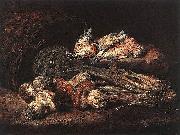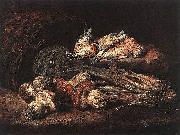
|
Joannes Fijt
|
|||
|
|
|||
| (15 March 1611 - 11 September 1661) was a Flemish Baroque animal painter and etcher. Fyt was born in Antwerp, where he was baptized on 15 June 1611, he was registered in 1621 as apprentice to Hans van den Berghe, who was a restorer of old pictures rather than a painter of new ones. Fyt then trained with Frans Snyders between about 1629-31, during which time, at the age of twenty, he entered the guild of St Luke as a master. From then until his death in 1661, he produced a vast number of paintings in which the bold facility of Frans Snyders is united to the powerful effects of Rembrandt, and harmonies of gorgeous tone are not less conspicuous than freedom of touch and a true semblance of nature. He left Antwerp for Paris in 1633, travelling on to Italy the following year, where he worked in Venice and probably visited Rome (as he later joined the Guild of Romanists back in Antwerp). By 1641 he was back in Antwerp, where he married in 1654. Hunting trophiesFyt excelled in the rendering of animal life in its most varied forms. He may have been less correct in outline, less bold in action than Snyders, but he was much more skilful and more true in the reproduction of the coat of deer, dogs, greyhounds, hares and monkeys, whilst in realizing the plumage of peacocks, woodcocks, ducks, hawks, and cocks and hens, he had no equal, nor was any artist even of the Dutch school more effective in relieving his compositions with accessories of tinted cloth, porcelain ware, vases and fruit. He was not clever at figures, and he sometimes trusted for these to the co-operation of Cornelius Schut or Thomas Willeboirts Bosschaert, whilst his architectural backgrounds were sometimes executed by Quellyn. Silenus amongst Fruit and Flowers, in the Harrach collection at Vienna, Diana and her Nymphs with the Produce of the Chase, in the Belvedere at Vienna, and Dead Game and Fruit in front of a Triumphal Arch, belonging to Baron von Rothschild at Vienna, are specimens of the co-operation respectively of Schut, Willeborts and Quellyn. They are also Fyt's masterpieces. The earliest dated work of the master is a cat grabbing at a piece of dead poultry near a hare and birds, belonging to Baron Cetto at Munich, and executed in 1644. The latest is a Dead Snipe with Ducks, of 1660, sold with the Jäger collection at Cologne in 1871. Great power is shown in the bear and boar hunts at Munich and Ravensworth castle. A Hunted Roedeer with Dogs in the Water, in the Berlin Museum, has some of the life and more of the roughness of Snyders, but lacks variety of tint and finish. A splendid specimen is the Page and Parrot near a table covered with game, guarded by a dog staring at a monkey, in the Wallace collection. With the needle and the brush Fyt was equally clever. He etched 16 plates, and those representing dogs are of their kind unique. | |||
|
|
|||
|
Mushrooms new25/Joannes Fijt-768353.jpg Måleriet identifieringen:: 84574 |
Date first half of 17th century Medium Oil on wood Dimensions Height: 49 cm (19.3 in). Width: 63.5 cm (25 in). cjr | ||
|
|
|||
|
Joannes Fijt
|
|||
|
|
|||
| (15 March 1611 - 11 September 1661) was a Flemish Baroque animal painter and etcher. Fyt was born in Antwerp, where he was baptized on 15 June 1611, he was registered in 1621 as apprentice to Hans van den Berghe, who was a restorer of old pictures rather than a painter of new ones. Fyt then trained with Frans Snyders between about 1629-31, during which time, at the age of twenty, he entered the guild of St Luke as a master. From then until his death in 1661, he produced a vast number of paintings in which the bold facility of Frans Snyders is united to the powerful effects of Rembrandt, and harmonies of gorgeous tone are not less conspicuous than freedom of touch and a true semblance of nature. He left Antwerp for Paris in 1633, travelling on to Italy the following year, where he worked in Venice and probably visited Rome (as he later joined the Guild of Romanists back in Antwerp). By 1641 he was back in Antwerp, where he married in 1654. Hunting trophiesFyt excelled in the rendering of animal life in its most varied forms. He may have been less correct in outline, less bold in action than Snyders, but he was much more skilful and more true in the reproduction of the coat of deer, dogs, greyhounds, hares and monkeys, whilst in realizing the plumage of peacocks, woodcocks, ducks, hawks, and cocks and hens, he had no equal, nor was any artist even of the Dutch school more effective in relieving his compositions with accessories of tinted cloth, porcelain ware, vases and fruit. He was not clever at figures, and he sometimes trusted for these to the co-operation of Cornelius Schut or Thomas Willeboirts Bosschaert, whilst his architectural backgrounds were sometimes executed by Quellyn. Silenus amongst Fruit and Flowers, in the Harrach collection at Vienna, Diana and her Nymphs with the Produce of the Chase, in the Belvedere at Vienna, and Dead Game and Fruit in front of a Triumphal Arch, belonging to Baron von Rothschild at Vienna, are specimens of the co-operation respectively of Schut, Willeborts and Quellyn. They are also Fyt's masterpieces. The earliest dated work of the master is a cat grabbing at a piece of dead poultry near a hare and birds, belonging to Baron Cetto at Munich, and executed in 1644. The latest is a Dead Snipe with Ducks, of 1660, sold with the Jäger collection at Cologne in 1871. Great power is shown in the bear and boar hunts at Munich and Ravensworth castle. A Hunted Roedeer with Dogs in the Water, in the Berlin Museum, has some of the life and more of the roughness of Snyders, but lacks variety of tint and finish. A splendid specimen is the Page and Parrot near a table covered with game, guarded by a dog staring at a monkey, in the Wallace collection. With the needle and the brush Fyt was equally clever. He etched 16 plates, and those representing dogs are of their kind unique. | |||
|
|
|||
|
Mushrooms new25/Joannes Fijt-343847.jpg Måleriet identifieringen:: 88437 |
first half of 17th century Medium Oil on wood cyf | ||
|
|
|||
|
Also Buy::. For Following Paintings / Artists / Products, Please Use Our Search Online: |







